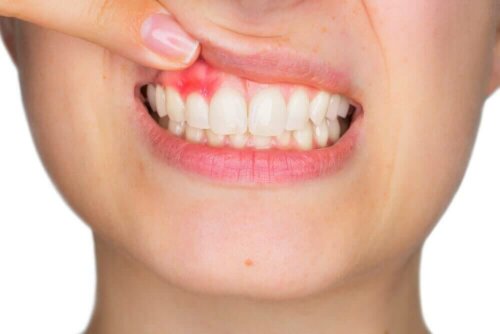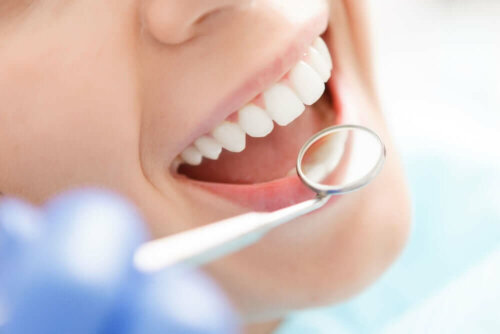Use of Hyaluronic Acid in Dentistry

Hyaluronic acid in dentistry has proven to be an effective treatment for conditions of the oral mucosa. It’s a substance that’s naturally present in the gums.
In treatment products, they use high molecular weight hyaluronic acid because it closely resembles the natural one in gum tissue.
The trials researchers have carried out have shown that the hyaluronic acid can be applied as a treatment, if it has characteristics similar to those of the hyaluronic acid that our bodies make. It contributes to the healing process and repairs damaged tissues.
How does hyaluronic acid act on the oral mucosa?

Hyaluronic acid is stored in the outer layers of healthy gum tissue. So, it works by forming a protective barrier over the mucosa, preventing the wound or injury from coming into contact with food and drinks.
Another property of hyaluronic acid is that it helps to reduce inflammation and discomfort thanks to its anti-edema effect, and it also helps to heal canker sores.
When you have periodontal disease, the affected tissues also have an increased need for hyaluronic acid.
What if you have a hyaluronic acid deficiency?
As we previously mentioned, when you have a condition, your need for hyaluronic acid increases. Therefore, this demand implies that there isn’t enough hyaluronic acid leading to inflammation and pain.
When there’s an injury to the mucosa of the mouth, the cells in charge of regenerating the tissue come to the area, causing delayed healing.
Read also: Treat and Prevent Canker Sores
Hyaluronic acid in dentistry
Dentists use hyaluronic acid often in the treatment of different conditions of the mouth, including the following:
- Mucosal inflammation: This includes gingivitis, gingival bleeding, gingival retraction, or gingival pockets.
- Traumatic conditions: in particular, wounds, oral cleanings, tooth extractions, or post-surgical treatment.
- Some diseases: certain diseases in which the mucosa of the gums requires a greater supply of hyaluronic acid.
What are canker sores?
Canker sores are small ulcers with a whitish background and red edges. Generally, they appear on the tongue, inside the cheeks and on the gums.
They’re more common in children and adolescents. On many occasions they cause strong pain on contact with certain foods or drinks.
Treatment with hyaluronic acid helps to alleviate the pain and discomfort caused by the presence of thrush. This is because it protects the injury and also accelerates the healing process.
You may also be interested in: 5 Ways to Cure Canker Sores Quickly
Benefits of hyaluronic acid in dentistry

- Pain relief: it forms a film that protects the injury and relieves pain.
- Protection against external agents: these agents include food and drinks.
- Tissue hydration: by forming a film, hyaluronic acid promotes water retention and, therefore, hydrates the affected tissue.
- Contributes to the healing process.
In addition, hyaluronic acid doesn’t hurt when applied; on the contrary, it produces a feeling of relief.
How to use hyaluronic acid
After your daily oral hygiene, apply hyaluronic acid three to five times a day for 3-4 weeks. However, we recommend that you wait to eat or drink for half an hour after applying it.
There are different products on the market that incorporate this substance in their composition. According to the way you use them, they’re classified as:
- Oral gel: apply a film on the affected area massaging with clean fingers to distribute it correctly.
- Rinse: rinse with 10 ml for 1-2 minutes, no dilution needed.
- Spray: each spray guarantees that it reaches the entire area with the same concentration. In general, the manufacturers recommend 1 or 2 sprays per day on the inflamed area.
Hyaluronic acid in dentistry
Hyaluronic acid has no local or systemic pharmacological effect on the oral mucosa. Indeed, it’s very safe and has no contraindications or adverse effects and you can use it without any restrictions. It’s ideal for use in children since it doesn’t hurt when applied and isn’t toxic.
All cited sources were thoroughly reviewed by our team to ensure their quality, reliability, currency, and validity. The bibliography of this article was considered reliable and of academic or scientific accuracy.
-
Sánchez, D. C., Yáñez Ocampo, B. R., & Esquivel Chirino, C. A. (2017). Uso de ácido hialurónico como alternativa para la reconstrucción de la papila interdental. Revista Odontológica Mexicana. https://doi.org/10.1016/j.rodmex.2017.09.008
-
González della Valle, A., García Rivello, H., & Mocetti, E. (1999). Identificación inmunohistoquímica de los fenómenos degenerativos en la hernia de disco lumbar: expresión de ácida hialurónico, metaloproteasas 1 y 3, factor de crecimiento fibroblástico básico y CD34. Rev. Asoc. Argent. Ortop. Traumatol.
-
Corte Sánchez, D., Yáñez Ocampo, B. R., & Esquivel Chirino, C. A. (2017). Use of hyaluronic acid as an alternative for reconstruction of interdental papilla. Revista Odontológica Mexicana. https://doi.org/10.1016/j.rodmex.2017.09.017
This text is provided for informational purposes only and does not replace consultation with a professional. If in doubt, consult your specialist.








